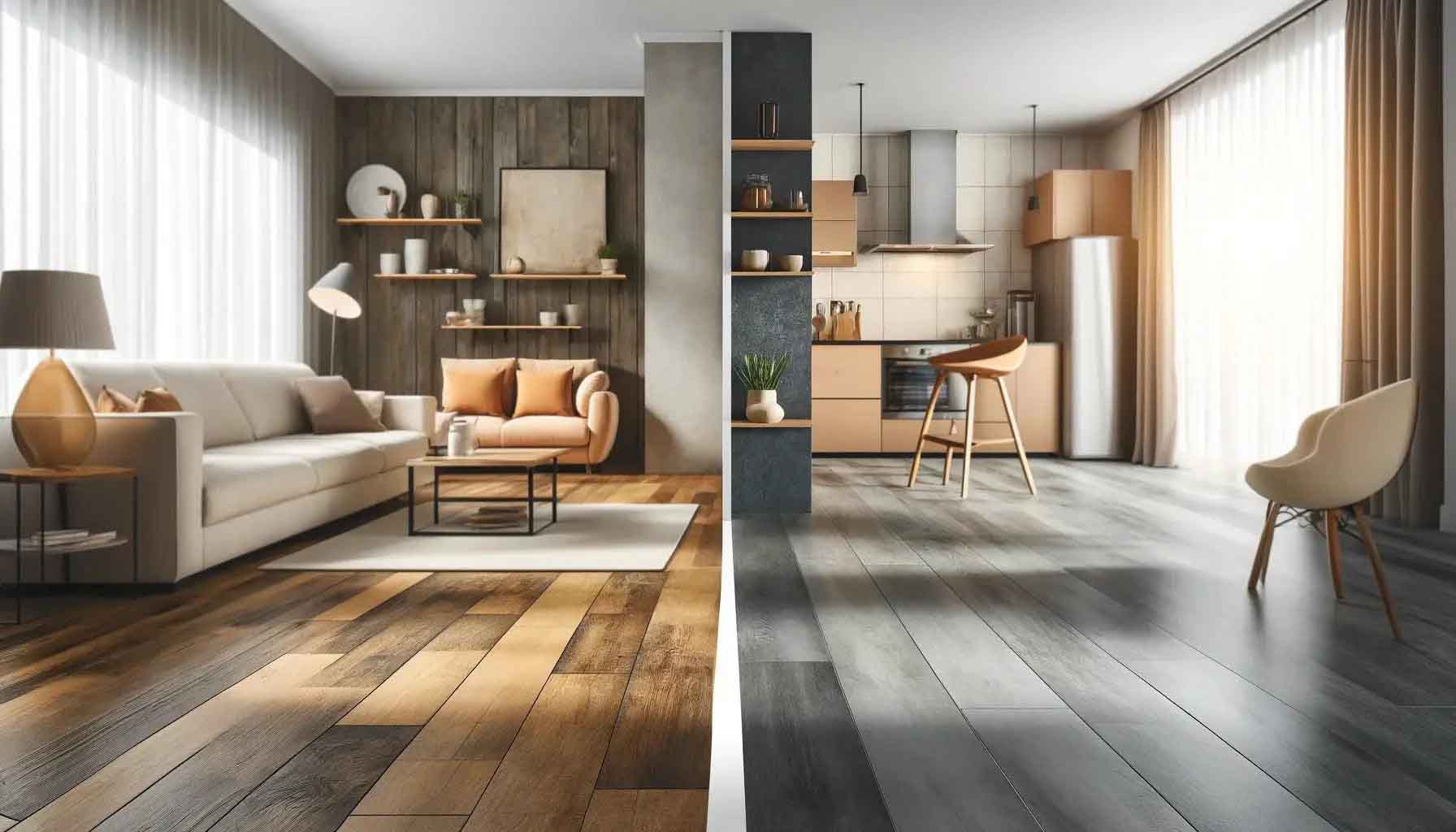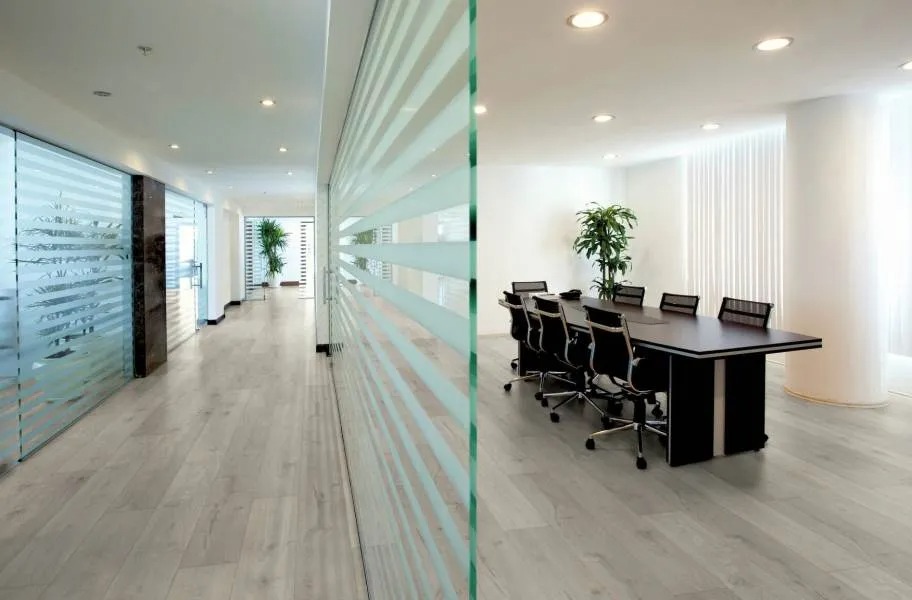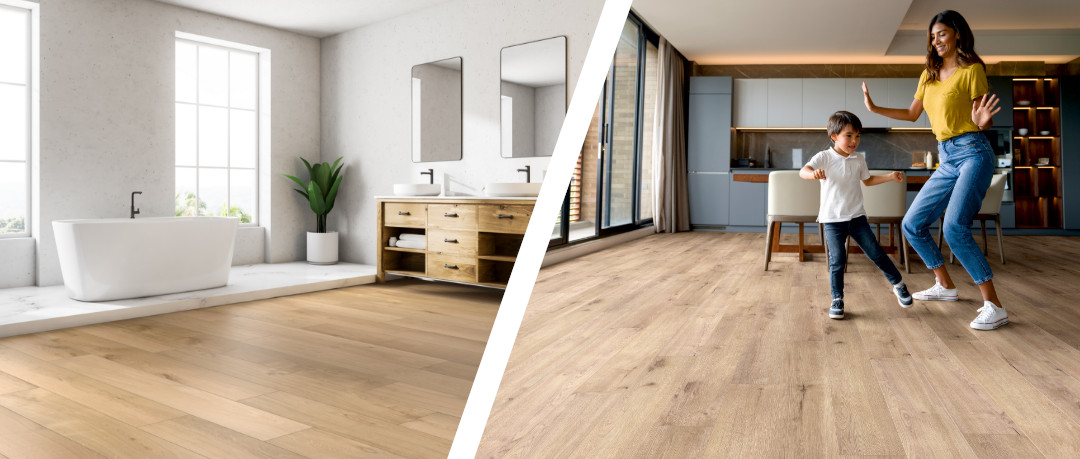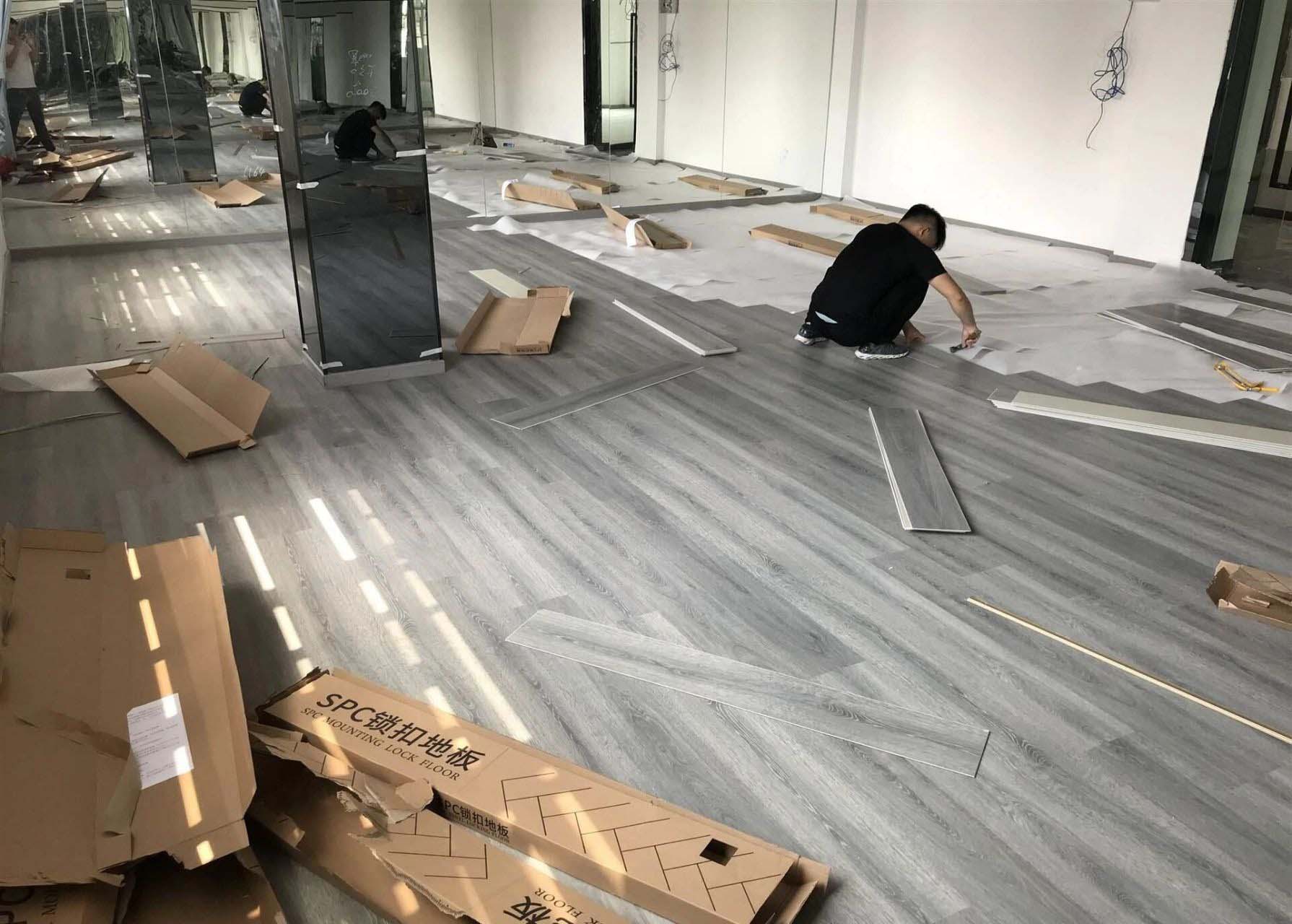Introduction
Choosing between luxury vinyl and SPC flooring can feel like a high-stakes decision for interior designers and developers. One misstep could mean sacrificing durability, aesthetics, or budget. With project demands pulling in every direction, how do you pick the right material?
Luxury vinyl vs. SPC isn’t just about looks—it’s about balancing comfort, cost, and long-term performance. From SPC’s **”rock-solid”** durability to vinyl’s design flexibility, this guide breaks down their differences to help you make choices that align with your vision and practical needs.
Foundations of Luxury Vinyl and SPC Flooring
Flooring sets the tone for any space, and choosing between luxury vinyl and SPC flooring can feel like a big decision. Both options shine in style and durability, but they differ in ways that matter for homes and businesses. Let’s break down what makes each one tick, from their makeup to their role in modern design.
Defining Luxury Vinyl Flooring: Composition and Types
Luxury vinyl flooring, often called LVP (luxury vinyl plank) or LVT (luxury vinyl tile), mimics wood or stone with stunning realism. It’s built in layers: a vinyl core, a printed design layer, and a tough wear layer. This setup makes it water-resistant and “chill-vibes” for high-traffic areas like kitchens or offices.
Unlike traditional vinyl, luxury vinyl vs. SPC offers flexibility in design, with endless colors and textures. It’s easy to install, often using click-lock systems, and works well over existing floors. However, its softer core can dent under heavy furniture if not properly supported.
Exploring SPC Flooring: Stone-Plastic Composite Core and Structure
SPC, or stone plastic composite flooring, takes durability up a notch. Its core blends limestone powder, polyvinyl chloride, and stabilizers, creating a rigid, rock-solid base. This makes SPC vs luxury vinyl a go-to for spaces needing extra toughness, like commercial settings.
The layered structure mirrors luxury vinyl but swaps the flexible core for a denser one. SPC resists scratches, stains, and fading, even in busy environments. Its stability also means it handles temperature swings better, reducing expansion or contraction issues.
Core Material Differences and Their Impact on Performance
The biggest difference in luxury vinyl vs. SPC lies in their cores. Luxury vinyl’s softer vinyl base offers cushioning underfoot, ideal for cozy homes, but it’s less resistant to extreme heat or cold. SPC’s limestone-heavy core laughs off those challenges, staying stable in sun-soaked rooms or chilly basements.
Performance-wise, SPC edges out with better dent resistance, making it a favorite for heavy-duty spaces. Luxury vinyl, though, wins for comfort and quieter steps, which matters in residential settings. Choosing depends on whether you prioritize resilience or a softer feel.
Current Trends in Premium Flooring
Today’s flooring trends lean toward natural looks with bold twists. Wide planks and matte finishes dominate, with gray and earthy tones leading residential designs. Commercial spaces, meanwhile, crave low-maintenance options like SPC for its reliability in high-traffic zones.
SPC’s supply chain, backed by consistent quality from manufacturers like spcfloorfactory.com, ensures it meets large-scale project demands without hiccups. Eco-conscious buyers also love that both options often use recyclable materials, aligning with sustainable design goals.
“SPC flooring’s limestone-based core gives it unmatched stability, making it a top pick for durability in both homes and businesses.”
When asking, “Which is better, SPC or luxury vinyl flooring?” it boils down to your needs. SPC excels in tough conditions, thanks to its rigid core, while luxury vinyl brings warmth and versatility. Both elevate spaces, but SPC’s edge in temperature resistance makes it a standout for unpredictable climates.
SPC vs. Luxury Vinyl Flooring Comparison
| Feature | Luxury Vinyl (LVP/LVT) | SPC Flooring | Residential Suitability | Commercial Benchmark |
|---|---|---|---|---|
| Core Material | Flexible vinyl | Limestone + PVC | High (comfort-focused) | Moderate |
| Durability | Good (7-15 years) | Excellent (15-25 years) | Good | High |
| Water Resistance | 100% | 100% | Excellent | Excellent |
| Temperature Stability | Moderate | High | Good | Excellent |
| Installation Ease | Click-lock, glue-down | Click-lock | High | High |
Note: Durability based on wear layer thickness (12-20 mil for residential, 20+ mil for commercial). Temperature stability tested under -20°F to 140°F conditions.
Durability and Environmental Performance
When choosing flooring, durability and how it handles tough conditions are key. Luxury vinyl vs. SPC flooring both shine, but they cater to different needs. Let’s dive into what makes each stand out in wear, weather, and real-world use.
SPC’s Rigid Core: Limestone and Stabilizers for Superior Durability
SPC flooring’s rigid core, made of limestone, polyvinyl chloride, and stabilizers, is built like a tank. This mix delivers top-notch “rock-solid” flooring durability, resisting dents and scratches in busy spots. It’s why SPC thrives in places like retail stores or offices with constant foot traffic.
The core’s density means it holds up under heavy loads without warping. Unlike softer materials, SPC’s structure ensures long-term performance, often lasting 15-25 years with minimal wear. For commercial spaces, this reliability cuts maintenance costs significantly.
Luxury Vinyl’s Flexibility: Benefits and Limitations in Wear Resistance
Luxury vinyl flooring, with its flexible vinyl core, offers a softer feel underfoot, perfect for homes. Its wear layer protects against scratches, but it’s less resilient than SPC in extreme conditions. Heavy furniture can leave marks if not properly padded.
That flexibility makes luxury vinyl easier to install and quieter to walk on, a big plus for cozy spaces. However, its durability—typically 7-15 years—depends heavily on the wear layer’s thickness, which varies by product.
Waterproofing and Temperature Stability: SPC vs. Luxury Vinyl
Both luxury vinyl vs. SPC are 100% waterproof, laughing off spills in kitchens or bathrooms. SPC, though, takes the lead in temperature stability, thanks to its limestone-heavy core. It stays steady in extreme heat or cold, from -20°F to 140°F, without expanding or contracting much.
Luxury vinyl handles moderate climates well but can warp in unheated spaces or under intense sunlight. For environments with big temperature swings, SPC’s rigid core flooring is the safer bet, ensuring no buckling or gaps over time.
Ideal Applications Based on Environmental Demands
SPC’s durability makes it a star for commercial spaces like malls or gyms, where flooring faces constant stress. Its SPC flooring advantages over luxury vinyl include better resistance to heavy equipment and foot traffic, aligning with procurement needs for high-traffic areas. Think bustling offices or retail floors that need to look sharp for years.
Luxury vinyl fits best in homes, where comfort and style matter most. It’s great for living rooms or bedrooms, offering warmth and a softer step. Both options work in rentals, but SPC’s edge in toughness suits long-term investments.
“SPC flooring’s rigid core offers unmatched durability, making it ideal for high-traffic areas and extreme climates.”
Choosing between these depends on your space’s demands. SPC’s core gives it a leg up for harsh conditions, while luxury vinyl brings a homier vibe. Either way, both deliver style and function for years.
Durability and Environmental Performance Comparison
| Feature | Luxury Vinyl | SPC Flooring | Residential Fit | Commercial Standard |
|---|---|---|---|---|
| Core Durability | Moderate | High | Good | Excellent |
| Wear Layer (mil) | 6-20 | 12-28 | Good | High |
| Waterproofing | 100% | 100% | Excellent | Excellent |
| Temperature Range (°F) | 0 to 120 | -20 to 140 | Moderate | High |
| Traffic Tolerance | Light-Medium | High | Good | Excellent |
Note: Wear layer thickness impacts lifespan; commercial standards require 20+ mil. Temperature range based on manufacturer testing.
Comfort, Aesthetics, and Design Versatility
Flooring isn’t just about function—it’s about how it feels and looks. Luxury vinyl vs. SPC flooring both deliver stunning visuals and comfort, but each has its own flair. Let’s explore their style, feel, and how they fit into today’s design trends.
Luxury Vinyl’s Design Range: Mimicking Wood, Stone, and More
Luxury vinyl plank nails versatility with designs that mimic hardwood, stone, or even tile. From rustic oak to sleek marble, its printed layer offers endless patterns, making it a go-to for bold home makeovers. It’s also eco-friendly, with recyclable options that vibe with green projects.
This flexibility lets designers craft unique spaces without breaking the bank. Luxury vinyl’s ability to pair with underfloor heating adds a cozy bonus. It’s perfect for homeowners chasing a custom look on a budget.
SPC’s Aesthetic Options: Balancing Style with Structural Integrity
SPC flooring keeps it classy with a premium look backed by its tough SPC core. Its designs rival luxury vinyl, offering wood grains and stone textures that hold up in high-traffic spots. The rigid core ensures those visuals stay sharp, even under heavy use.
SPC’s stability means it won’t warp or fade, making it a solid pick for sunny offices or busy shops. Its polished finish adds a touch of luxe to any space, blending style with grit.
Comfort Underfoot: Comparing Warmth and Cushioning
Luxury vinyl feels softer underfoot, thanks to its flexible core, giving it a warm, cushioned vibe. It’s quieter too, soaking up footsteps in cozy bedrooms or playrooms. For folks wanting that “homey glow”, it’s a clear winner.
SPC, with its denser core, feels firmer but still comfy enough for daily life. It shines in spaces where durability trumps softness, like kitchens or retail floors. Both handle spills well, but luxury vinyl’s slight give feels homier.
Customization Trends for Interior Design Projects
Designers today crave flooring that pops. Wide planks, herringbone patterns, and earthy tones rule residential projects, with luxury vinyl leading for its easy customization. SPC’s catching up, offering trendy matte finishes and bold layouts for upscale vibes.
Cost comparison SPC vs luxury vinyl shows both fit tight budgets, but luxury vinyl’s green options appeal to eco-conscious builds, aiding sustainable procurement. SPC’s durability, driven by its limestone core, makes it a long-term investment for commercial spaces.
“Luxury vinyl’s design flexibility lets homeowners create custom looks, while SPC’s rigid core blends style with unbeatable toughness.”
Choosing between these depends on your vibe. Luxury vinyl’s warmth and variety suit homes, while SPC’s sturdy elegance fits demanding spaces. Both elevate any project with looks that last.
Design and Comfort Comparison
| Feature | Luxury Vinyl | SPC Flooring | Residential Appeal | Commercial Fit |
|---|---|---|---|---|
| Design Variety | High (wood, stone, tile) | High (wood, stone) | Excellent | Good |
| Comfort Level | Soft, warm | Firm, stable | High | Moderate |
| Eco-Friendly Options | Recyclable materials | Some recyclable | High | Moderate |
| Pattern Customization | Herringbone, wide plank | Wide plank, matte | Excellent | Good |
| Visual Longevity | Good (7-15 years) | Excellent (15-25 years) | Good | High |
Note: Visual longevity based on wear layer (12-20 mil residential, 20+ mil commercial). Comfort assessed via core flexibility.
Cost Comparison and Long-Term Value
Flooring choices impact your wallet today and years down the line. Luxury vinyl vs. SPC flooring offers different price points and benefits, making it key to weigh costs against value. Let’s break down the numbers to help you plan smart.
Upfront Costs: Material and Installation Expenses
Luxury vinyl typically costs $2-$7 per square foot, depending on design and thickness. Installation runs $1-$3 per square foot, often lower with click-lock systems that skip glue. It’s a budget-friendly pick for homes needing style without a huge upfront hit.
SPC, or stone plastic composite flooring, ranges from $3-$8 per square foot. Its rigid core flooring installs easily, keeping labor at $1-$2 per square foot. While slightly pricier, SPC’s durability can offset the initial spend over time.
Maintenance Requirements and Associated Costs
Luxury vinyl is low-maintenance, needing just sweeps and damp mops—about $50-$100 yearly for cleaning supplies in a typical home. Scratches might call for spot repairs, which are cheap but add up in busy spaces. It’s forgiving but not bulletproof.
SPC’s tough surface resists wear, cutting maintenance to $30-$80 a year. Its “no-sweat” upkeep suits high-traffic areas like shops, where time and money on cleaning matter. Both options dodge pricey refinishing, unlike hardwood.
Longevity and Replacement Cycles: SPC vs. Luxury Vinyl
Luxury vinyl lasts 7-15 years with proper care, depending on its wear layer (6-20 mil). Heavy use can shorten this, meaning replacements come sooner in bustling homes. That impacts long-term budgeting, especially for rentals.
SPC shines with a 15-25-year lifespan, thanks to its limestone-packed core. It resists dents and fading, delaying replacement costs. For developers, this makes SPC a cost-effective choice for projects needing lasting value.
ROI Considerations for Commercial and Residential Projects
Cost comparison SPC vs luxury vinyl shows SPC’s edge in ROI for commercial spaces. Its longevity lowers turnover costs in offices or retail, where foot traffic is relentless. Developers love its low-maintenance vibe for high-value builds.
Luxury vinyl suits homes or smaller projects, offering solid returns through affordability and style. Both boost property appeal, but SPC’s durability often tips the scale for bigger investments. Eco-friendly options in both add value for green certifications.
“SPC flooring’s longer lifespan and low upkeep make it a smart investment for budget-conscious commercial projects.”
Choosing between these hinges on your goals. Luxury vinyl vs. SPC balances upfront savings against long-term gains, with SPC’s rigid core giving it an edge in tough spots. Either way, both deliver value that lasts.
Cost and Value Comparison
| Feature | Luxury Vinyl | SPC Flooring | Residential ROI | Commercial ROI |
|---|---|---|---|---|
| Material Cost ($/sq.ft.) | 2-7 | 3-8 | High | Moderate |
| Installation Cost ($/sq.ft.) | 1-3 | 1-2 | High | High |
| Annual Maintenance ($) | 50-100 | 30-80 | Good | Excellent |
| Lifespan (years) | 7-15 | 15-25 | Moderate | High |
| Replacement Frequency | Medium | Low | Moderate | High |
Note: Costs based on 2025 market averages. ROI assessed via lifecycle savings and property value impact.
Installation, Maintenance, and Decision-Making Guide
Choosing the right flooring means understanding how it’s installed, cared for, and fits your space. Luxury vinyl vs. SPC flooring offers unique perks, and knowing their differences helps professionals pick wisely. Let’s walk through the process and tips to nail your project.
Installation Methods: Click-Lock vs. Glue-Down
Luxury vinyl plank often uses click-lock systems, snapping together like puzzle pieces for quick installs. It’s DIY-friendly, cutting labor costs to $1-$2 per square foot. Glue-down options, used in larger spaces, add stability but bump costs to $2-$3.
SPC flooring leans heavily on click-lock, thanks to its rigid core, making it a breeze for big jobs. Glue-down is less common but works for uneven subfloors. SPC’s streamlined supply chain, like at spcfloorfactory.com, ensures pros get quality stock fast.
Maintenance Tips for Longevity and Appearance
Luxury vinyl stays sharp with regular sweeping and occasional damp mopping—about $50 a year in supplies. Avoid harsh cleaners to protect its wear layer, and use felt pads under furniture to dodge scratches. It’s low-effort but needs consistent care.
SPC’s tougher surface resists scuffs, so maintenance is even easier, costing $30-$70 yearly. A quick sweep and mild soap keep it gleaming. Its limestone core shrugs off wear, making it a “set-it-and-forget-it” choice for busy spots.
Room-Specific Recommendations
For kitchens, both SPC and luxury vinyl shine, handling spills like champs. Luxury vinyl’s softer feel suits homes, while SPC’s durability fits commercial kitchens. Bathrooms lean toward SPC for its temperature stability in humid conditions.
Offices love SPC vs luxury vinyl for its dent resistance under desks and chairs. Retail spaces also favor SPC’s ability to stay pristine. For cozy bedrooms, luxury vinyl’s warmth and quiet step win out, creating a snug vibe.
Decision Framework: Balancing Budget, Durability, and Aesthetics
Budget-wise, luxury vinyl’s lower upfront cost ($2-$7 per square foot) appeals to smaller projects. SPC ($3-$8 per square foot) costs more but saves long-term with less upkeep and longer life. Both offer stunning designs, from wood to stone looks.
Durability is SPC’s ace, with its limestone core resisting heat and wear for 15-25 years. Luxury vinyl lasts 7-15 years, better for lighter use. Aesthetics are a toss-up—both nail modern trends like wide planks and matte finishes.
“SPC’s easy click-lock installation and tough core make it a top pick for pros tackling large, high-traffic projects.”
How does the installation process differ between SPC and luxury vinyl flooring? SPC’s rigid core simplifies click-lock setups, while luxury vinyl offers glue-down flexibility. Your choice depends on space, budget, and vibe—SPC for toughness, luxury vinyl for cozy charm.
Installation and Maintenance Comparison
| Feature | Luxury Vinyl | SPC Flooring | Residential Ease | Commercial Fit |
|---|---|---|---|---|
| Install Method | Click-lock, glue-down | Click-lock | High | High |
| Labor Cost ($/sq.ft.) | 1-3 | 1-2 | High | High |
| Maintenance Cost ($/yr) | 50-100 | 30-70 | Good | Excellent |
| Lifespan (years) | 7-15 | 15-25 | Moderate | High |
| Room Suitability | Bedrooms, kitchens | Offices, retail | High | Excellent |
Note: Labor costs based on 2025 averages. Lifespan tied to wear layer (12-20 mil residential, 20+ mil commercial).
Conclusion
After years of working with flooring, I’ve seen how the right choice can transform a space. Luxury vinyl brings warmth and endless design options, perfect for cozy homes, while SPC’s tough core handles the demands of busy commercial spots with ease.
Both options deliver style and function, but it’s about what fits your vibe. For me, the beauty lies in balancing comfort with durability to create spaces that last. Picking between them isn’t just a purchase—it’s a long-term investment in your project’s success.
Think about your space’s needs and how you want it to feel. Choosing the right flooring is a **”no-brainer”** when you weigh aesthetics against performance. What’s the one thing your project can’t compromise on—style or strength?
FAQ
-
Q1: What is the difference between luxury vinyl and SPC flooring?
A1: Luxury vinyl flooring consists of softer layers and is more flexible, providing comfort underfoot. SPC, or Stone Plastic Composite, has a rigid core made of limestone and stabilizers, making it highly durable and ideal for high-traffic areas.
-
Q2: Is SPC flooring better than luxury vinyl?
A2: SPC flooring is considered better in terms of durability and water resistance due to its strong rigid core. However, luxury vinyl offers more flexibility and comfort underfoot, which may be preferable in residential settings.
-
Q3: What are the advantages of SPC flooring?
A3: SPC flooring is highly resistant to impacts and temperature fluctuations, is completely waterproof, and is durable enough for both residential and commercial spaces. It also has a rigid core that adds to its stability.
-
Q4: How does SPC flooring compare to engineered hardwood?
A4: SPC flooring is waterproof, easier to install, and has a rigid core that resists scratches better than engineered hardwood. In contrast, engineered hardwood offers a traditional wood aesthetic but requires more maintenance.
-
Q5: What are the cost differences between SPC and luxury vinyl flooring?
A5: SPC flooring may initially have a higher cost due to its durability and material composition, but it may offer better long-term value with less maintenance and higher durability compared to luxury vinyl.
-
Q6: Is SPC flooring suitable for all rooms?
A6: Yes, SPC flooring is suitable for all rooms, including areas prone to moisture like kitchens and bathrooms, due to its waterproof nature. Its durability makes it ideal for high-traffic areas as well.
-
Q7: What makes SPC flooring more durable than luxury vinyl?
A7: SPC’s durability comes from its rigid core, which includes limestone, making it denser and less prone to dents and impacts. It withstands heavy usage and temperature changes better than traditional luxury vinyl.
-
Q8: Are there any drawbacks to using SPC flooring?
A8: While SPC is durable and waterproof, it may lack the softness and warmth of traditional luxury vinyl underfoot, and installation can be more complex due to its rigid nature.
External Links
- Luxury Vinyl Planks vs. SPC Vinyl: Which One is Right for You?
- Luxury Vinyl Plank vs. SPC Vinyl: Which One is Right for You?
- SPC vs. LVP Flooring: An In-Depth Guide to Comparing Types
- SPC vs. WPC Luxury Vinyl Flooring: Key Differences Explained
- What To Know About Luxury Vinyl Flooring – This Old House
- Engineered Hardwood vs. Luxury SPC Vinyl: Which is Right for You?
- Difference Between SPC Flooring vs WPC, LVP, PVC, Vinyl – Floormonk
- Rigid Core Luxury Vinyl: SPC vs WPC Flooring – Flooring Clarity







